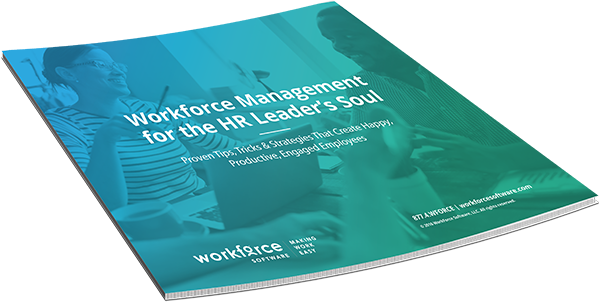“How and why should my company use labor data?” asked the CEO.

Kent Herschel, CEO, called in a specialist named Heath Rondell.
In a past life, Heath was a competent leader with workforce management experience and knowledge. Today, Heath helps companies make the most of their labor budget. He stepped into Kent’s office, shook his hand and sat down.
“You’ve been around the block a few times, Heath,” said Kent, scrolling through his website.
“Twenty years,” said Heath. “I know all the streets, all the intersections.”
Kent smiled, then asked a poignant question:
“How and why should my company use labor data?”
Heath had a sip of water.
“Employees are a company’s single greatest expense,” said Heath. “As such, they’re also every company’s greatest opportunity to drive down costs and improve performance.”
Kent nodded.
“Of course,” Heath went on, “people also drive innovation and productivity, profitability. That’s why I see workforce management as something that isn’t solely the domain of HR and Payroll. Instead, I look at a workforce management solution as having company-wide applicability and utility.”
“Makes sense,” said Kent, focused.
Employees are a company’s single greatest expense. As such, they’re also every company’s greatest opportunity.
“So, to answer your question: The labor data you get from your workforce management system should be used to inform your business decisions—because the two go hand-in-hand.”
Subscribe to The WorkForce Blog
Learn the art and science of maintaining productive, happy, engaged employees.
“Decisions around what business functions?” asked Kent.
Heath took another sip.
“Labor data can be used to address a range of functions, but the biggest benefits lie with these three…”
1. “Operations.”
Gaining a more nuanced view of actual versus projected labor costs equips operations professionals with information they can convert into organizational efficiency. Organizations with accurate and granular information can more precisely adjust other factors of the business to align with labor activities, including logistics and production.
Data can also be used to forecast future labor demand, helping managers accordingly plan out their shifts.
2. “Compliance.”
Complying with employment law regulations can easily consume dozens of work hours per pay period. While compliance activities are largely tactical, the same data-centric approach that supports strategic labor analytics can also help organizations streamline compliance.
Approached differently, digitalizing your organization’s time and labor activities can deliver dramatic improvements to compliance activities as well as enable year-round strategic HR.
3. “Safety.”
Employee safety is closely linked to employee fatigue, but it has several other tie-ins to labor data. For example, Employee Mark has to maintain several certifications in order to drive the equipment he needs to do his job. A modern, sophisticated workforce management system would alert Mark and his manager when such certifications are about to expire, protecting employees as well as the business.
If that system has analytics capabilities, then your organization would be able to assess the overall level of certification amongst other skills and employee preferences, and plan scheduling adjustments, work orders, inventory, and staffing decisions based on that holistic understanding of your current workforce.
“I can see why analytics is critical” said Kent, “but how can we get the right labor data?
Heath cleared his throat.
“This is where digital workforce management comes into play. A comprehensive workforce management solution can give you the labor analytics you’re looking for—just make sure…”
 Workforce Management for the HR Leader’s Soul
Workforce Management for the HR Leader’s Soul
This book will help you create a healthy, rewarding environment for the people that keep your company moving forward.
1. You have full coverage of your workforce and processes.
You should be able to get insights for every employee, not only the majority.
In other words, if 90% of the workforce is automated and the other 10% is addressed outside of the system (using manual process, for instance), then that’s dangerous because it leaves room for errors. Errors that create gaps in the data. Gaps that can have a devastating effect on labor analysis.
2. It is convenient and easy to use.
The reality is that many data-collection tools like webclocks, wall terminals, and interactive voice response (IVR) systems are being replaced with smartphones. That iPhone in your pocket does it all, yes, but most importantly, it’s convenient, always there, ready.
Make data capture a simple, convenient, routine part of the work day for your employees.
Whatever employees use to input data, the principle that determines success has and always will remain unchanged: Make data capture and consumption a simple, convenient, routine part of the work day.
It’s this combination of convenience and ease-of-use that’ll make your workforce management system sticky, even addictive to workers, who will be engaged by their newfound control.
3. Your data is auditable.
Also known as a “paper trail”, auditability is important from a compliance standpoint, as it provides evidence that rules were adhered to and standards were met.
It’s also important to your continual improvement, as having a clear and readily available snapshot of events can highlight the root cause of any concerns that may float to the surface.
“Thanks for coming in, Heath. Mike will be in touch.”
Kent stood up first. Heath popped up in tandem. They shook hands and Heath walked out.
Kent sat back down and opened his Outlook. He needed to write his executive team an email…
Labor data drives good business decisions.
A modern, sophisticated workforce management solution will help you discover those critical workforce analytics.

 Workforce Management for the HR Leader’s Soul
Workforce Management for the HR Leader’s Soul